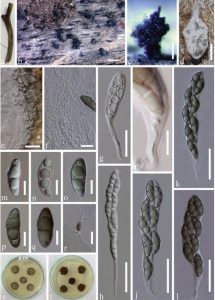Helicascus uniseptatus J. Yang, J.K. Liu & K.D. Hyde, sp. nov., Index Fungorum number: IF 552251
Etymology: With reference to uniseptate ascospores.
Saprobic on decaying, submerged twigs in aquatic habitats, visible as masses of brown ascospores on the host surface. Sexual morph: Ascostromata 100–200 μm diam, 300–500 μm high, solitary or aggregated in small groups, black, immersed, subglobose or obovate, appearing as slightly raised regions with black ostioles, with periphyses, papillate, black. Peridium 40–48 μm, comprising three fused layers, outer layer darker, with thick-walled cells of textura globosa, middle layer pale brown with thin-walled cells of textura angularis, and inner layer hyaline with flattened, thin-walled cells. Hamathecium composed of septate, hypha-like pseudoparaphyses, 2.2–4.2 μm wide, constricted at the septa, ramified above asci with free ends, embedded in a gel matrix. Asci 130–240 × 16–26 μm (x̅ = 165 × 22 μm, n = 25), 8-spored, bitunicate, fissitunicate, clavate, long pedicellate, base of endoascus long, narrow and coiled within ectoascus, ectoascus uncoiling to form a long tail-like extension, apically rounded with a cylindrical ocular chamber. Ascospores 25–32 × 9–13 μm (x̅ = 27 × 10 μm, n = 35), ellipsoid-fusiform, 2-seriate, uniseptate, constricted at the septum, apical cell usually longer than basal cell, hyaline when young, becoming brown when mature, guttulate, smooth-walled, lacking a mucilaginous sheath. Asexual morph: Undetermined.
Material examined: THAILAND, Chiang rai Province, stream flowing near ThamLuang Nang Non Cave, on submerged wood, 25 November 2014, Yang Jing, YJ-4 (MFLU 15–1170, holotype); ex-type living culture, MFLUCC 15–0057.
Notes: Helicascus uniseptatus was collected from decaying wood submerged in a freshwater stream in Chiang rai Province, Thailand. H. uniseptatus is similar to H. unilocularis by its unilocular ascostromata and ascospores with a smooth wall and lacking a mucilaginous sheath. However, H. uniseptatus differs from H. unilocularis in having smaller ascostromata (100–200 versus 200–220 μm), a thinner peridium (40–48 versus 50–65μm), and longer ascospores (25–32 versus 23–25.8 μm). In addition, H. uniseptatus is phylogenetically close to H. elaterascus in the phylogenetic analysis, but H. uniseptatus differs from H. elaterascus in having smaller ascostromata, and smooth ascospore lacking a mucilaginous sheath, while H. elaterascus has verruculose ascospores with mucilaginous sheath. Based on the morphological characters and phylogenetic analysis, we introduce this fungus as a new species in Helicascus.
FIG. Helicascus uniseptatus (MFLU 15–1170, holotype) a Specimen; b Appearance of masses of ascospores on surface of host; c Mass of spores on host surface; d Section of ascoma; e Section of peridium; f Paraphyses; g–l Asci; m–q Ascospores; r Germinating ascospore; s, t Culture grow on PDA after 4 weeks, s upper side, t reverse side. Scale bars: b = 1000 μm; c = 200 μm; d = 100 μm; e, f = 15 μm, g, i = 30 μm; h, j–l, r = 40 μm; m–q = 10 μm.

